
Next Collectible
2019 BMW X5 xDrive50i
By Dan Scanlan
 Do you find it hard to wrap your brain around the concept that an SUV can also perform like a sports sedan?
Do you find it hard to wrap your brain around the concept that an SUV can also perform like a sports sedan?
Many manufacturers have tried, but the Germans and Japanese seem to nail it – Porsche Cayenne, Infiniti QX50, Mercedes-Benz AMG GLE 63 and Audi SQ5 come to mind. So does the BMW X5 SUV – ahem, they call it a Sports Activity Vehicle.
When the X5 debuted in 1999, it was a radical departure for a company known for the “Ultimate Driving Machine.” That brings us to this fourth generation X5. There are more than 2.2 million in the world, one-third in the U.S., all built in Spartanburg, S.C. And while the overall look hasn’t changed much since the third-gen version finished its 6-year run, there’s differences.
BMW body – Park our Phytonic Blue Metallic next to a 2018 model, and you’d be hard pressed to see the 2019’s changes. The wheelbase is 1.6 inches longer, the body just an inch longer and taller, plus 2.6-inches wider. Some of that isn’t apparent but look closer.
The familiar upright twin-kidney grill is more squared off and taller, a gentle inward tuck where it joins a black bumper inside the wide-mouth lower intake. There’s a short front overhang, but the boxier nose design appears a bit longer. The quad headlights’ high beams are now Laser lights, up 10 times brighter than LED headlights. Quad headlights get familiar BMW halo DRLs, an LED “eyebrow” over each. Side inlets grow more squared off, with real inlets and winglets under LED fog lights. It’s much more aggressive than 2018.
The gently rounded roofline’s slim roof rails frame a long moonroof. Our model had M Sport additions like 10-spoke satin alloy and pewter wheels showing huge disc brakes with blue M-badged calipers front and rear, all shod with P275/45R20-inch Pirelli Scorpion Zero run-flat rubber. The wheel wells wrap nicely around the rubber for a fairly hunkered-down look.
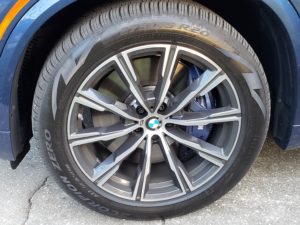 Other changes: gloss black front fender vents and a design line that rises on the rear fenders under the traditional Hofmeister Kink – that forward bend at the base of the D-pillars. Twin LED taillights wrap around each rear corner. The lower fascia gets a black accent punctuated by quad exhausts in alloy tips.
Other changes: gloss black front fender vents and a design line that rises on the rear fenders under the traditional Hofmeister Kink – that forward bend at the base of the D-pillars. Twin LED taillights wrap around each rear corner. The lower fascia gets a black accent punctuated by quad exhausts in alloy tips.
X5 inside – As you approach, flowing puddle lamps project on the ground as door handles, headlights and taillights glow with the interior. Lit accents on open front door handles flash to warn approaching cars at night that you’ve opened them in their path. Inside, smoother shapes with richer detailing, a nice change from the squared-off look of the last generation X5. Multiple stitching accents leather on the sweeping dashtop as well as doors and center console. Gloss wood trimmed in alloy with accent lighting divides surfaces on the dashboard and center console. There’s M-Sport pedals, driver’s footrest and aluminum trim.
Bucket seats offer 14-way power adjustments and dual memory presets, firm and very supportive. The driver gets a thick leather-clad M Sport steering wheel with paddle shifters on its power tilt/telescope design. Smart cruise and safety system controls are on the left, with audio, phone and voice command on the other. Then comes what BMW calls “Live Cockpit Professional” – two 12.3-inch digital displays to replace the previous generation’s analog dials and buttons.
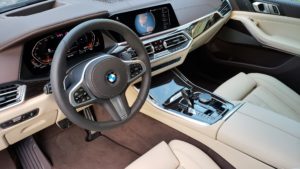
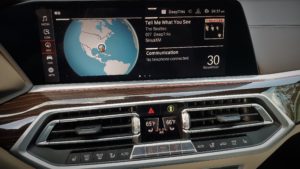
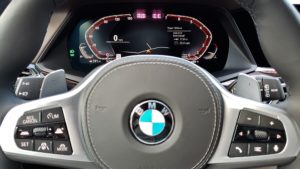 The gauge package is wide-screen with blue-lit 160-mph speedometer and miles-per-gallon display framing the look in ECO PRO mode, then turns red with 7,000-rpm tach in “Sport.” Navigation and map are center stage, with configurable safety and fuel mileage information port and starboard. There’s an infrared sensor in the gauge package that reads your hands on the steering wheel, bonging and flashing a warning if you don’t put both in the right places – sometimes even when my hands ARE at 9 and 3. The head-up display is a 7-inch’s worth of crisp mph and local speed limit, cruise control settings, lane departure warning, navigation, even audio and that steering wheel warning.
The gauge package is wide-screen with blue-lit 160-mph speedometer and miles-per-gallon display framing the look in ECO PRO mode, then turns red with 7,000-rpm tach in “Sport.” Navigation and map are center stage, with configurable safety and fuel mileage information port and starboard. There’s an infrared sensor in the gauge package that reads your hands on the steering wheel, bonging and flashing a warning if you don’t put both in the right places – sometimes even when my hands ARE at 9 and 3. The head-up display is a 7-inch’s worth of crisp mph and local speed limit, cruise control settings, lane departure warning, navigation, even audio and that steering wheel warning.
The free-standing center touchscreen handles driving, entertainment, navigation, connectivity, and vehicle info. It can be set up in any combination of four layouts. We could easily access an app screen with BMW Assist and Message, plus news, weather, parking services and more. There’s a sport display with real-time G-force, turbo boost, power, torque and engine temperature, and an off-road screen with tilt angles and compass. To change volume or stations/track, no more button or screen hunting. Make a hitchhiker’s thumb and slide one way or another in front of the screen, and you change stations. Twirl your index finger one way or another, and volume changes. The Harmon-Kardon surround-sound system was solid and clear, even at top volume.
The main screen’s audio, map, phone, navigation, settings and more are accessible via the iDrive twist/tap controller with its touch interface to finger-spell instructions. Voice command handles a lot of this as well. The center console’s twin cup holders chill or heat, with an inductive charger slot big enough for my larger smartphone. The Driving Dynamics Control Sets Comfort, Sport, Sport+, ECO PRO or adaptive driving modes for suspension, steering, transmission and engine. Auto Hold keeps the brakes on when you stop, releasing when you tap the gas. An engine auto stop/start feature saves gas, the V-8 re-firing fairly seamlessly as you step off the brake pedal. And tap the lock button three times on the remote to start the X5.
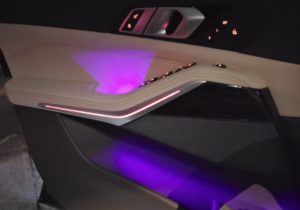
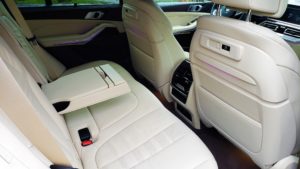 Back seat room is luxurious, with lots of head and leg room and a panoramic glass roof overhead, a center armrest and rear climate control with vents and more accent lighting. The two-section tailgate opens with a wave of a foot under bumper, revealing a large storage area with a deep well underfloor, plus switches to drop the second row’s 40/20/40 split seatbacks.
Back seat room is luxurious, with lots of head and leg room and a panoramic glass roof overhead, a center armrest and rear climate control with vents and more accent lighting. The two-section tailgate opens with a wave of a foot under bumper, revealing a large storage area with a deep well underfloor, plus switches to drop the second row’s 40/20/40 split seatbacks.
BMW go – A BMW is supposed to be a driving machine, even a 5,617-lb. sports activity vehicle. So while the BMW X5 xDrive40i gets a 3-liter twin-turbocharged inline 6-cylinder with 335 hp, our 50i had a twin-turbo 4.4-liter V-8 with 456 hp. Both funnel that through an eight-speed Steptronic transmission, on through xDrive all-wheel drive.
Drive modes start with ECO PRO that backs off throttle to save gas. It let me adjust steering and suspension feel to our favorite Sport setting and still have some fuel savings, aided by the auto stop/start. That said, the best we saw was about 14 mpg driving in ECO PRO.
My favorite was Sport or Sport+, which modifies the exhaust system for serious snarl on acceleration. It also gave us peak torque of 479 lb-ft as low as 1,500 rpm, meaning power on demand. We set launch control, deactivating stability control and planting drive mode in Sport+. Our 1,700-mile-old X5 dug in all four Pirellis and launched like a rocket to 60 mph in 4.2 seconds, and 100 mph in 10.8 seconds, accompanied by crisp upshifts and snarling bass exhaust. Passing power was there as soon as I tapped the gas. Sport mode gave us throttle blips on downshifts as well as exhaust snorts on up-shifts – it sounded wonderful.
The double-wishbone front axle and a five-link rear axle with electronically controlled dampers offers a more comfort-oriented or sportier firm feel depending on drive mode. Comfort softens it just a bit, still taut and quickly reactive to bumps. Sport was my go-to, with tight ride movement and very quick bump control with no harshness at compression, also dropping ride height .8 inches. The X5 has active roll stabilization to limit lean in corners. Add in all-wheel-drive with an electronically controlled rear differential lock that splits drive torque between the front and rear wheels and we had a heavy but very agile SAV. A control locking function for the rear differential improves traction over less grippy road surfaces by preventing a wheel from spinning when it is struggling for purchase. There’s also rear steering to improve turning or lane-changing agility.
The X5 was agile, flat and neutral at higher speeds than I expected on an expressway ramp. We certainly noticed a rear-biased set-up when playing hard, able to power the rear Pirellis out in a controlled manner in aggressive cornering. Nothing seemed to bother the X5. It was sure-footed even the pouring rain we had for much of our test week. We had almost no body roll on our skidpad, with slight and very controllable understeer when pushed in Sport+, which limits stability control. I could even goose the rears out with finesse. Since we didn’t have the optional off-road system with height adjustment, skid plates and dirt/mud/rock settings, the rain kept me from playing on dirt (now mud). In all modes, especially Sport, steering was spot on, with lots of feel and precision. The brake-by-wire system had a nice bite high on the pedal and solid, nose dip-free stops with no drama and no fade after repeated use.
Our X5 was almost self-driving with optional Active Driving Assistant, adding blind spot detection, lane departure warning, cross traffic alert, and rear/frontal/pedestrian collision warning. We had top, panorama and 3D camera views on the main screen for ease of parking. There’s self-parking and a Back-Up Assistant. The latter is handy when you drive down a narrow driveway and want to back out without hitting anything. The system will automatically steer you backward as your ride the brake, counting down until you get to the start of the driveway up to about 50 meters. It worked fine.
Active cruise control maintains speed and distance, coming to a full stop when traffic does, then resuming when it moves again, without touching the “resume” button.” Traffic Jam Assist handled stop and go driving hands- and foot-free, up to 5 mph. Lane Keeping Assistant was very active and annoying, always nudging the steering wheel too much to keep the X5 centered. And the steering wheel would sometimes pull one way or another when I detected nothing, as if the SAV was trying to help me.
X5 finances – The X5 xDrive40i starts at $60,700, and our 50i xDrive starts at $75,750 plus $995 destination, with standards like launch control, dynamic dampers, navigation, two 12.3-inch digital displays, adaptive full LED headlights and panoramic sunroof. Our options included: $1,700 Driving Assistance Plus; $3,650 Dynamic Handling; $3,800 M Sport Package; $2,050 Premium Package; $2,050 Executive Package with adaptive LED headlights with laser high beams; and $1,200 leather dashboard. Final price was a lofty $91,005.
For comparison, a similar Porsche Cayenne Turbo with 550-hp V-8 is $125,000, the 550-hp V-8 $103,000 Mercedes-Benz AMG GLE 63, 354-hp V-6 $52,400 Audi SQ5 and 295-hp V-6 $46,000 Infiniti QX50. The Porsche hits 60 mph in 4.5 seconds; the rest range from the Benz’s 5.3 seconds to the Infiniti’s 8. The Porsche really handles the street well, a bit better than the others – my choice if money is no object.



Bottom line – BMW proves again that a big SUV can move, handle and comfort like a luxury sports car, and sound great doing it – at a price.
Just the Facts
2019 BMW X5 xDrive 50i
Vehicle type — 5-door, 5-passenger luxury sport crossover sports activity vehicle
Base price — $75,750 (as tested: $91,005)
Engine type – 4.4-liter twin-turbocharged 32-valve V-8
Horsepower (net) 456-hp @ 5,250-6,000 rpm
Torque (lb-ft) 479 @ 1,500-4,750 rpm
Transmission — 8-speed automatic
Wheelbase – 117.1 inches
Overall length – 194.3 inches
Overall width – 87.3 inches w/mirrors
Height – 69 inches
Front headroom – 39.8 inches w/moonroof
Front legroom – 40.8 inches
Rear headroom – 38.7 inches
Rear legroom – 38.7 inches
Cargo capacity – 33.9-cu.ft./72.3 w/rear seats folded
Towing capacity – up to 6,600 lbs.
Curb weight – 5,170 lbs.
Fuel capacity – 21.9 gallons
Mileage rating – 17 city/22 highway





